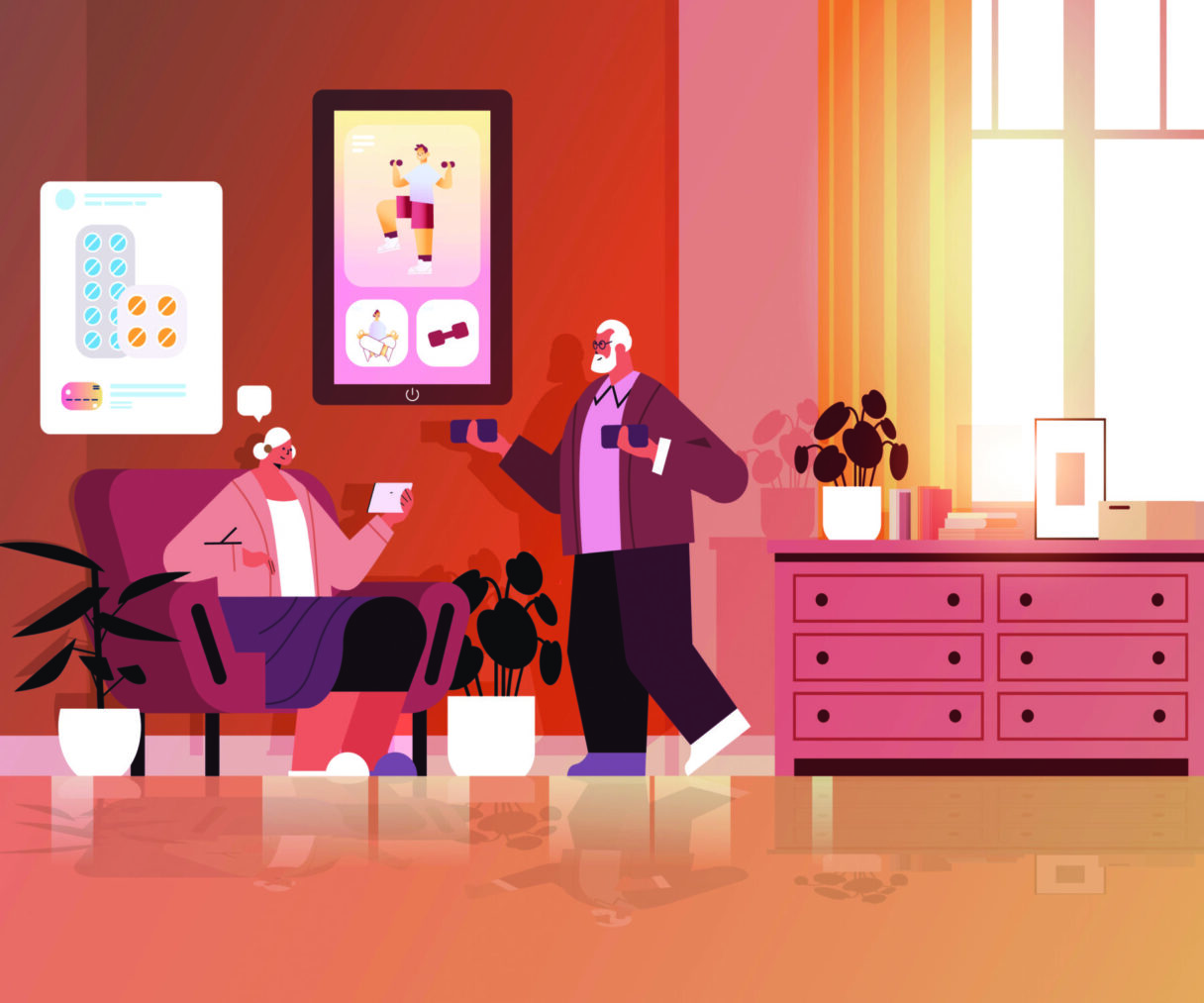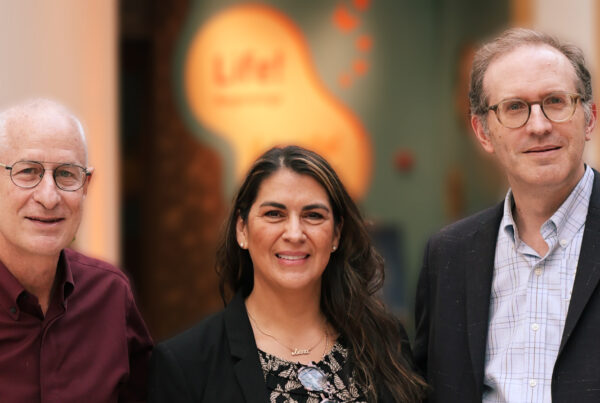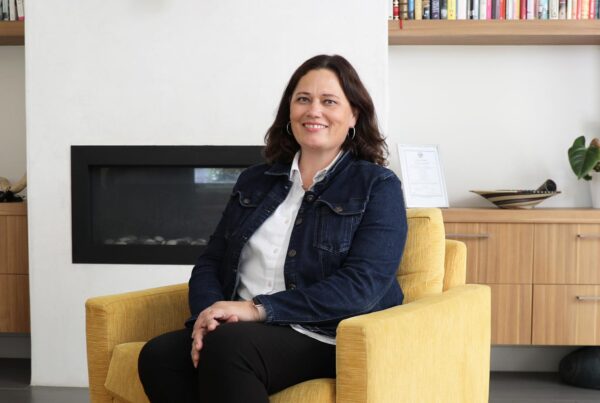They won’t be your grandparents’ golden years. Tomorrow’s older adults will have very different lifestyles, thanks to advancements in health, technology, education and more. Several experts from the USC Leonard Davis School of Gerontology share what they feel will be the most important advances for daily life in the future.
Medicine: Powered by Personalization
Following successes in genetically tailored cancer treatment, we are on the cusp of exciting new fronts in fighting other diseases of aging with genomic-based personalized interventions, says USC Leonard Davis School Dean Pinchas Cohen. The ability to capitalize on large data sets allows us to begin to predict who might be at risk for certain conditions and to target treatment and prevention efforts accordingly.
In addition, the discovery of microproteins, including those encoded in the smaller mitochondrial genome, have introduced new possibilities for treatments for diabetes, obesity and more.
“If you think about everything you know about biology, science has tried to explain [everything] by the existence of 20,000 genes, which is what people believed until recently are the number of large genes in the genome,” Cohen says. “In fact, microproteins represent hundreds of thousands of additional, recently recognized novel, small genes, which will reshape how we understand science.”
Community: Embracing Intergenerational Living
“Age-restricted communities — communities solely for older adults — are increasingly seen as outdated. They miss the many benefits of vibrant, age-diverse communities,” says Paul Irving, USC Leonard Davis visiting scholar and senior fellow at the Milken Institute.
“What kind of society are we building — a society that encourages understanding and collaboration and appreciation of others, or a society that reinforces the divides that already challenge America?” Irving asked in an interview with Rethinking65.com. “I would make the case that bringing older and younger Americans together enhances the lives of both age groups, and in the mix increases the likelihood of collaboration, mutual understanding and appreciation.’’
Intergenerational, age-friendly communities promote interaction between younger and older people, according to Irving. The relationships that result can reduce loneliness and social isolation for both age groups, he adds.
“I strongly believe in the value of diverse environments. Diversity has been America’s great strength, and it still is,” Irving says. “We know that diversity in communities and institutions holds great potential. And it is time to include age in the diversity matrix. I’m excited to see more and more enlightened leaders doing just that—designing and building and planning in ways that integrate different races, cultures and age cohorts.”
Money: Taking Aging Into Account
With people not only living longer lives but also working longer, and perhaps embarking on encore careers, planning for one’s financial future will need to be informed by the realities of aging. That’s where financial gerontology comes in.
Cynthia Hutchins MAG ’13, director of financial gerontology at Bank of America, said in an interview with Financial Advisor that financial gerontologists are trained to “ask the right questions of their clients, the more probing and personal questions that are outside the realm of the financial.” She noted that this includes taking into consideration health issues, where they want to live, whether they want to continue to work part time, and how they want to spend their leisure time.
Through a certificate program launched in 2015 with Bank of America, the USC Leonard Davis School has taught this holistic perspective to nearly 1300 financial advisors thus far. USC Leonard Davis Senior Associate Dean Maria Henke explained to Financial Advisor that trained financial gerontologists know how to explore the deeper issues regarding aging and finances, from asking about caregiving wishes to noticing potential indicators of dementia or financial abuse.
“When advising about retirement options like whether to save money by moving to a different community, a financial gerontologist would consider factors like risk of social isolation, access to health care or opportunities for meaningful engagement, in addition to financial impacts,” Henke said.
Food: Tailored Diets for Longevity
The increased push for personalizing medicine based on individual characteristics will likely one day include nutrition, allowing people to learn what type of diet will best suit their unique needs, including their genetics, says Professor Sean Curran.
“I think everybody knows somebody who’s done a fad diet that had amazing results — and then similarly either tried that diet themselves or knows someone who did the exact same diet, only to find it didn’t work at all,” Curran says. “The reason that the results were different was because of the genetic makeup of the individual. So I think this is a new way of thinking about personalized medicine, but taking it from a personalized diet standpoint. Rather than prescribing a one-size-fits-all diet, [we’re] looking at the genetic makeup of an individual and then one day being able to prescribe to them: ‘Here are the types of food that you should avoid, and here are the types of food that you should increase consumption of on a daily basis.’”
We’ve learned more about the general characteristics of the optimal diet for longevity, which includes parts of the Mediterranean and Okinawan diets, incorporates a daily 12-hour time window for eating, and also recommends periodic, short fasting-mimicking diets a handful of times each year, says Professor Valter Longo. These recommendations can easily be adapted to individuals based on sex, age, health status and genetics, he adds. For instance, in order to counter frailty and loss of lean body mass, people over age 65 may need to increase not only protein intake, but also the variety of animal-derived foods they consume.
For people who are looking to optimize their diet for longevity, Longo says it’s important to work with a health care provider who specializes in nutrition on personalizing a plan focusing on smaller changes that can be adopted for life.
“The longevity diet is not a dietary restriction intended to only cause weight loss, but a lifestyle focused on slowing aging and on minimizing frailty, which can complement standard health care—and, taken as a preventative measure, will aid in avoiding morbidity and sustaining health into advanced age,” he says.
Connection: Virtual Reality for Socialization, Health Care and More
It’s not just for video games: Virtual reality and the metaverse could one day have a myriad of important applications for nongamer older adults.
The concept of the metaverse was popularized in the science fiction novel Snow Crash, by Neal Stephenson, where the term refers to a digital universe that can be accessed through virtual reality. This digital environment can give users the feeling of being present with someone who’s not physically there, something that has immense possibility for older adults who are experiencing social isolation, says Dean Pinchas Cohen.
Along with giving people the ability to meet or “travel” with friends and family in the metaverse, research indicates that virtual reality has therapeutic potential for anxiety, pain, loneliness and more, Cohen says. When paired with the use of sensors or wearable tech, it can also create a more immersive environment for brain exercise and reminiscence therapy and can augment telehealth services.
“For older adults facing mobility challenges and loss of social connections, virtual reality and the metaverse could become a key method for staying engaged with their social network and keeping mentally active,” Cohen says.
For Older Adults and Tech, Access Is Key
Contrary to stereotypes, older adults are embracing technology. The pandemic-related rise in older adults’ use of smartphones, tablets and apps continued in 2021, according to an AARP tech trends report. Devices carried in pockets, worn on wrists and installed in homes are helping today’s tech-savvy older adults maintain connections, prevent falls, stay active, detect disease, get rides, order food and more.
But access and affordability still prevent many from benefiting from technology innovations. Professor Kate Wilber is working to bridge this digital divide. She leads a team evaluating California governor Gavin Newsom’s efforts to expand technology adoption among older adults. She’s also surveying telehealth usage among older adults at home and in skilled nursing facilities. Here’s what she’s learned so far:
Broadband is essential.
“People not only need to have some kind of device, they also need to have broadband, and it needs to work. We’ve seen that there is lack of access to broadband in parts of the U.S., especially in rural areas. This is an essential service, and we need to do a better job of providing it across the nation.”
Hardware is not enough.
“If you hand somebody a box with a computer in it and say, ‘Here you go — you’re now going to go on the other side of the digital divide,’ they’re not. How do we help people learn? We need to do a better job helping people learn, including improving cultural competencies required for trainers. We also need to be sensitive to a variety of different uses that people want. This means being person-centered and engaging the people who will be the end users, and understanding what’s most effective for them.”
The future is bright.
“There are so many exciting innovations that are rolling out. We need to build on what we’re learning and to make them better and more effective to help those on the wrong side of the digital divide connect.”





